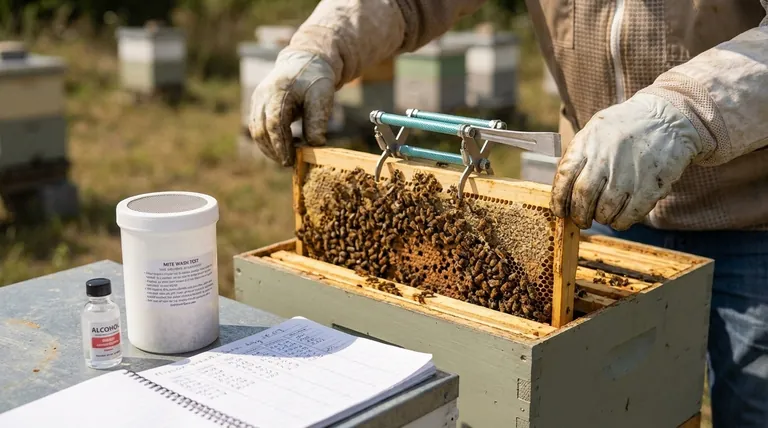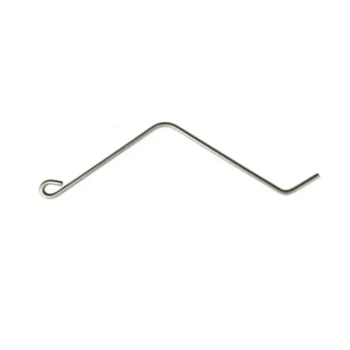Consistent mite monitoring is the single most critical practice for modern beekeeping success. It is essential because Varroa mite populations grow exponentially and can spike from seemingly low levels to colony-destroying numbers in a matter of weeks. Regular checks provide the data needed to intervene at the right time, preventing catastrophic losses before they happen.
The core purpose of monitoring is to shift from reactive crisis management to proactive hive stewardship. It’s not just about counting mites; it's about understanding their growth curve to apply targeted controls before the infestation reaches a point of no return, protecting both the individual hive and the surrounding apiary.

The Deceptive Nature of Varroa Mite Infestations
The greatest challenge with Varroa mites is that their threat is often invisible until it is too late. A hive that appears strong and productive can be harboring a rapidly growing mite population that will soon overwhelm it.
Mite Populations Grow Exponentially
A low mite count in the spring is not a sign of safety; it is merely a starting point. As the queen bee ramps up egg-laying, she provides more and more brood cells for mites to reproduce in, causing their population to explode alongside the bee population.
The Problem Remains Hidden
Varroa mites do their damage inside the capped brood cells, feeding on developing bees. By the time you see visible symptoms in adult bees, such as deformed wings or parasitic mite syndrome (PMS), the infestation is already severe and the colony's health is critically compromised.
A Race Against Time
Consistent monitoring allows you to see the mite population's growth trend. This data is the only reliable way to know when an intervention is required to prevent the population from reaching a critical threshold.
From Monitoring to Informed Action
Monitoring transforms your management decisions from guesswork into a precise, data-driven strategy. It tells you exactly what is happening inside your hive and what you need to do about it.
Establishing Treatment Thresholds
The goal is not to eradicate every single mite, which is impossible. The goal is to keep the mite population below an established economic threshold—the point at which their numbers begin to cause significant harm and economic loss to the colony.
Timing Treatments for Maximum Impact
Monitoring dictates the optimal time to treat. Applying treatments when mite loads are still manageable ensures the bees that will make up the winter cluster are raised healthy and strong. Treating too late, after high infestation levels are reached, is often ineffective.
Preventing Re-infestation
Unmanaged hives with high mite loads become "mite bombs." As these colonies weaken, they are robbed by bees from stronger, healthier hives nearby. This act of robbing rapidly transfers thousands of mites to the healthy colonies, creating new infestations.
Understanding the Trade-offs of Inconsistent Monitoring
Failing to monitor consistently is not a neutral choice; it carries significant risks that can lead to the loss of your hives and impact other beekeepers in your area.
The High Risk of Sudden Colony Collapse
The most direct consequence of poor monitoring is unexpected colony death. A hive that appears to be thriving in August can be completely dead by October if a spike in the mite population goes unnoticed.
The Inefficiency of Blind Treatment
Without data from monitoring, beekeepers often treat on a fixed schedule, regardless of need. This can lead to applying unnecessary chemicals in the hive or, conversely, failing to treat when a serious infestation is building.
Contributing to a Wider Problem
Neglecting to manage mites in your own hives directly endangers the bees of other beekeepers in your vicinity. Responsible beekeeping includes managing pests to protect the health of the entire local bee population.
Making the Right Choice for Your Goal
Your approach to monitoring should be guided by your primary objective as a beekeeper. A practical schedule involves checking at least three to four key times: early spring, mid-summer after the main honey flow, late summer before raising winter bees, and a final check in late fall.
- If your primary focus is the survival of your colonies: Commit to a regular monitoring schedule to catch mite population spikes before they become irreversible.
- If your primary focus is cost-effective treatment: Use data from mite counts to apply treatments only when thresholds are crossed, saving money and reducing chemical exposure in the hive.
- If your primary focus is community-minded beekeeping: Monitor consistently to prevent your hives from becoming "mite bombs" that threaten the health of neighboring apiaries.
Ultimately, consistent monitoring transforms beekeeping from a game of chance into an informed practice of effective stewardship.
Summary Table:
| Key Monitoring Benefit | Impact on Your Apiary |
|---|---|
| Tracks Exponential Growth | Prevents mite populations from spiking to destructive levels. |
| Enables Proactive Treatment | Allows for timely intervention before visible damage occurs. |
| Prevents 'Mite Bomb' Hives | Protects your entire apiary and neighboring colonies from re-infestation. |
| Informs Cost-Effective Management | Ensures treatments are applied only when necessary, saving time and money. |
Protect Your Investment and Your Apiary with HONESTBEE
Consistent monitoring is the foundation of successful beekeeping, but you need the right tools to do it effectively. HONESTBEE supplies commercial apiaries and beekeeping equipment distributors with the durable, reliable supplies required for accurate mite counts and proactive hive management.
Stop guessing and start making data-driven decisions to ensure the health and productivity of your colonies. Contact our wholesale experts today to discuss your apiary's needs and discover how our equipment can support your monitoring regimen.
Visual Guide

Related Products
- Professional 3-Bar Frame Grip with Integrated Hive Tool
- HONESTBEE Advanced Ergonomic Stainless Steel Hive Tool for Beekeeping
- Professional Dual-End Stainless Steel Hive Tool for Beekeeping
- Adjustable Formic and Acetic Acid Dispenser for Bee Mite Treatment
- Lightweight Durable Plastic Queen Excluder Scraper for Beekeeping
People Also Ask
- What are Frame Grips used for in beekeeping? Boost Your Hive Inspection Efficiency & Bee Safety
- What products pair well with Frame Grips for beekeeping? Build Your Complete Hive Inspection Toolkit
- What should beginners consider when purchasing beekeeping equipment? A Guide to Essential Starter Gear
- What does every bee keeper need? Your Essential Guide to Starting Strong
- What parts of bee equipment should be painted? A Guide to Protecting Your Hive and Your Bees



















